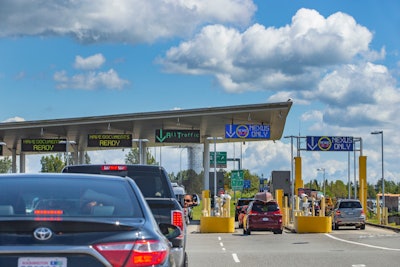 USCMA, which replaces the 1994 North American Free Trade Agreement, is expected to spur investment in Mexico and help bolster cross-border freight movement.
USCMA, which replaces the 1994 North American Free Trade Agreement, is expected to spur investment in Mexico and help bolster cross-border freight movement.Out with the old, and in with the new.
The 25-year-old North American Free Trade Agreement has been scrapped and replaced with an updated trade pact between the U.S. and North American neighbors Canada and Mexico. Congress ratified the pact and President Donald Trump signed it into law late last month.
Simply dubbed the United States-Mexico-Canada Agreement (USMCA), the deal is largely seen as a positive for U.S. truckers and for cross-border freight movement — in large part by ending the lingering uncertainty surrounding trade with North American trade partners Canada and Mexico since negotiations began in 2017.
“Perhaps one of the most important things with USMCA is we’re going to avoid irrational tariff activity that could significantly disrupt freight movement at both borders,” says Kenny Vieth, president and senior analyst at ACT Research. The deal “makes tweaks to the existing paradigm,” rather than opting for a “whole new way of doing business,” he says.
In 2018, the most recent year for cross-border freight data, trucks moved $772 billion in goods between the U.S. and Canada and Mexico, according to the Bureau of Transportation Statistics. That cross-border truck freight movement only stands to benefit from the new deal, says Bob Costello, chief economist at the American Trucking Associations.
“It’s not going to add freight volume overnight,” says Costello, “but in the long-run it will not only add to freight volume in North America, it will help keep freight here.”
One of the chief accomplishments of USMCA, says Costello, is updating NAFTA to prevent the trade pact from going stale. “My concern prior to USMCA was, if we don’t have a modern trade agreement with our two largest trade partners, you could see some of that production leaving North America and going other places,” such as southeast Asia, he says. “If that were to happen, you would not get the truck freight movement across the border like we’re getting today.”
Additionally, the lingering trade dispute between the U.S. and China has spurred greater investment in manufacturing in Mexico, says Jason Seidl, managing director of airfreight and surface transportation at investment firm Cowen Inc. The USMCA deal will spur even more investment in Mexico, says Seidl, likely creating more cross-border freight activity.
Lastly, the USMCA deal retains the cross-border program instituted by NAFTA that allows Mexican-domiciled carriers to obtain operating authority in the U.S., which allows them to operate outside of the commercial border zone.
Though the deal includes provisions to allow the U.S. DOT to cap the number of Mexican carriers who receive authority or put a moratorium on granting authority to Mexican carriers, the annex only allows U.S. regulators to do so if they “determine that limitations are required to address material harm or the threat of material harm to U.S. suppliers, operators, or drivers,” according to the annex text.
The Office of the U.S. Trade Representative (USTR) says no such material harm or threat of harm exists currently.
USMCSA retains the prohibition on Mexican carriers hauling freight between points in the United States. All loads must be cross-border loads.
The pact awaits approval by the Canadian government but has been ratified by Mexico and the U.S.












